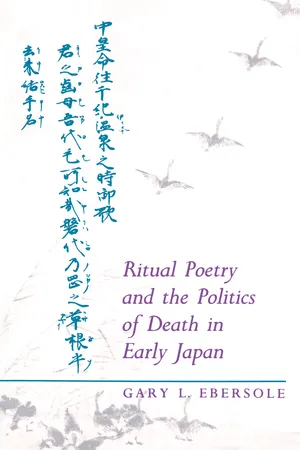![]()
CHAPTER ONE
Ritual Poetry in the Court
Poetry in preliterate Japan was more than “just” literature. In fact, it is incorrect and misleading to speak of “literature” at all in a primary oral culture such as Japan was before the introduction of the Chinese script. All poetry was orally performed, either sung or recited, giving it an immediacy that a written text does not have. Poems were performances or acts, not artifacts. Thus it is no accident that the word for a Japanese poem (uta) is the same as that for song (uta), whereas Chinese poems (i.e., originally “written poems”) are clearly distinguished and are called shi. The early Japanese did not distinguish religion, politics, and literature in the ways we do, for poetry/song participated immediately in these other dimensions of social life to a far greater extent than is now generally recognized. Verse forms were at once part of an intellectual discourse and a social practice. It will be one of the goals of this and later chapters to indicate some of the ways uta functioned in the life of the early Japanese in the stage of secondary orality, the transitional period in which oral performative forms survived alongside writing that was being introduced among the intelligentsia. It is this period from which the earliest extant texts discussed here date.
Not all poetry in early Japan was ritual poetry, of course, so the comments and generalizations below concern a selected group of poems, including examples of the major types of ritual poetry found in early Japan such as land-viewing and praise poems, dialogue poems, commemorative poems of imperial excursions, poems for the pacification of the spirit of a deceased individual, and funeral laments. Moreover, the primary focus will be on the functional aspects of this ritual poetry rather than on the specifically aesthetic dimensions.
Only by taking the immediate socio-political aspects of public performative poetry into full account can such poems serve as significant documents in historical studies. Without in any way seeking to ignore or play down the aspects of continuity that characterize religious ritual and ritual poetry, it is also important to consider whenever possible the intentions of the human agents engaged in the performance of public rituals and ceremonies. In doing so, we must pay careful attention to the occasion of a reported performance as well as the relative socio-political positions and relationships of the performer (or in the case of a surrogate performer, his patron) and his/her audience. The same verse can “mean” different things on different occasions, with different audiences. Viewed in isolation, or out of its performative context, ritual—and ritual poetry—too easily appears as a timeless and essentially “frozen” expression of human religiosity.
In attempting to deal with Japanese poetry of the primary oral stage or even the early secondary stage one immediately faces a difficult methodological problem: direct access to this oral performative poetry is impossible. Paradoxically, perhaps, the only access to the oral stage of early Japan is through written texts that have survived. These texts, however, were not intended to serve as ethnographic monographs, and the oral poems incorporated within them are frequently preserved out of their generative and performative loci and, moreover, sometimes in altered form. Nevertheless, because the earliest texts, including the Kojiki, the Nihonshoki, and the Man’yōshū, come out of Japan’s transition from a primarily oral culture to a literate one, at least among the intelligentsia and in the court, they preserve enough evidence of the oral aspects of the culture to permit certain generalizations. The textual evidence, however, must be supplemented by and interpreted in light of what scholars have learned about orality since the pioneering work of Milman Parry in the 1920s.1
The work of historians of religions often involves the informed imaginative recreation of earlier ritual performances based upon limited textual evidence. Any study, such as the present one, that seeks to relocate the (now) literary texts in their earlier performative contexts will have to use comparative data from other cultures in order to recreate these contexts imaginatively. Introducing comparable examples from other cultures and times where appropriate enables one not only to supplement the available textual data but also to avoid the myopic (and sometimes ideologically and ethnocentrically informed) assumption that early Japan represents a unique cultural and religious situation.
Japanese folklorists such as Tsuchihashi Yutaka2 have produced an impressive number of studies on the Kikikayō and Man'yōshū poems in which they have attempted to reconstruct the rituals mentioned in the poetry by using contemporary Japanese agricultural festivals and planting songs, as well as ethnographic studies of other cultures, as comparable situations, and then extrapolating backward. Konishi Jin’ichi has also recently used comparative material in his study of early Japanese poetry.3 Such developments in the field of Japanese studies must be acknowledged and applauded, even when one is unable to accept all the authors’ suggestions and conclusions. The results of the research of these and other Japanese scholars deserve to be more widely known but also need to be supplemented and extended.
The Prestige of Poetry
Poetry or song (uta) figures prominently in the extant texts from early Japan, so by studying these texts one is able to gain some sense of the function of poetry in early Japan. Song was frequently used and experienced as a form of the exercise of power. It was a linguistic means of manipulating religio-political power in the human sphere as well as of manipulating the spiritual powers, including the kami and the spirits of the dead. Song was sung and poetry recited not only for aesthetic pleasure but as a means of ordering and controlling potentially dangerous aspects of the world. This sense of the efficacy of poetic language survived until much later in Japanese history and was prominent in the Heian and medieval periods. Indeed, it is still found in the present in attenuated form...
